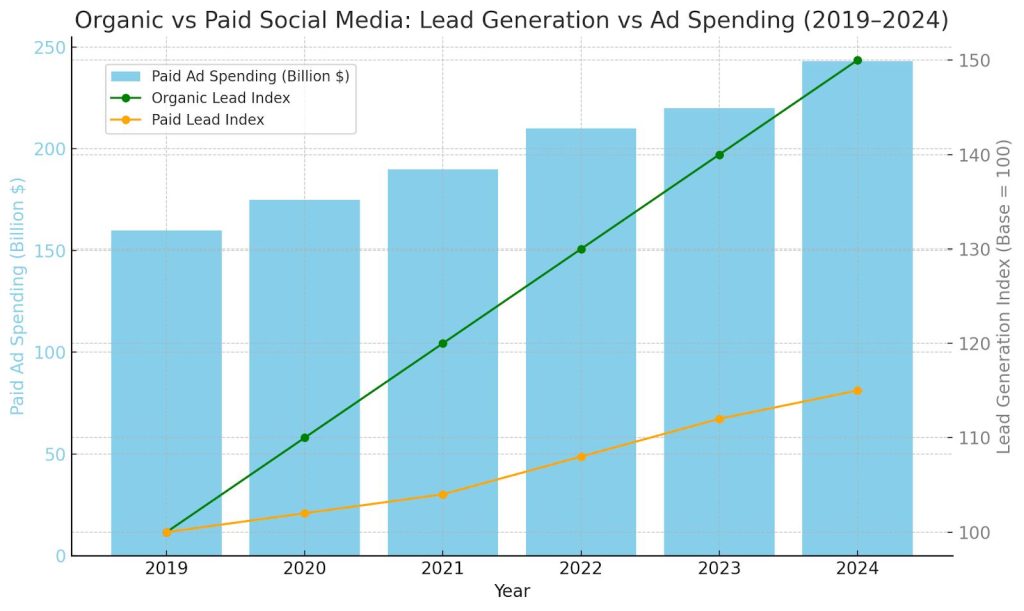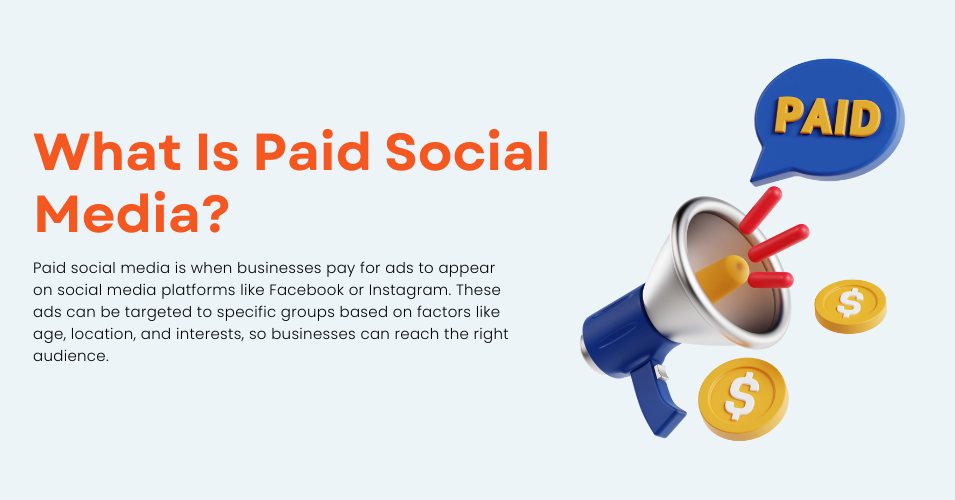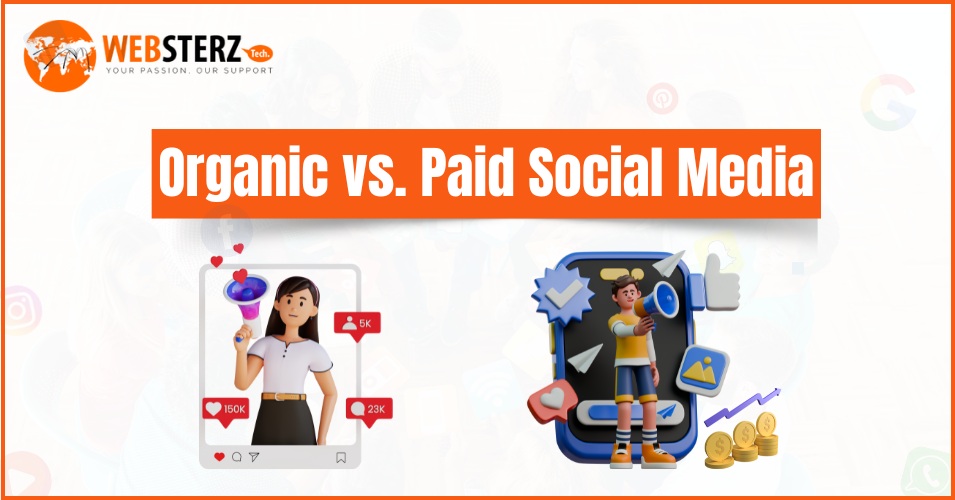| Did you know? As of 2025, over 5.24 billion people—about 64% of the world’s population—are using social media. |
Social media is a big part of our daily lives, and it is also a powerful way for the health and wellness sector to connect with people. Since almost everyone is scrolling, liking, and sharing every day, it gives therapists, counselors, chiropractors, etc., a great chance to reach their audience. However, here is the tricky part—should you grow your page naturally (that is, organic social media), or should you pay for ads to get faster results?
It is not always easy to decide, because both options have their own pros and cons.
Some studies say that organic social media brings in twice as many leads (potential customers) compared to paid posts. But on the other hand, global spending on social media ads reached $243 billion in 2024—up by 15% from the previous year and more than 50% higher than 2019. That shows more and more businesses are turning to paid ads to get quicker results and reach more people.

So, what should your business do?
In this blog, we will skim through what organic and paid social media really mean, what is good (and not so good) about each, and how you can choose the best path for your goals.
What is Organic Social Media?
Organic social media is when businesses share posts, photos, videos, and stories on social media without paying for ads. It is about building a presence by connecting with your audience naturally.
However, it can be hard because social media platforms use algorithms that decide what shows up. It takes time and effort, but with the right approach, organic social media marketing for therapists can help grow your brand and connect with more people.
Examples of organic social media activities include-
- Share updates, tips, or stories often on your page—without paying to promote them
- Get your team involved by having them share company posts with their own friends and followers
- Reply to people’s comments and messages quickly, and make sure your responses sound real and friendly
- Highlight content made by your customers or followers, and create a welcoming space for interaction—without using paid rewards.
When you post organically, your content reaches-
- A percentage of your followers (your ‘organic reach’)
- Your followers’ followers (if people choose to share your post)
- People following any hashtags you use
Organic social media is the foundation of every digital marketing strategy because it helps brands-
- Establish their personality and voice
- Build relationships by sharing informative, entertaining, or inspiring content
- Engage customers at every stage of their buying journey
- Support their customers with customer service
This is how organic media works; it takes time, but it eventually helps you grow.
-
Advantages of Organic Social Medias
One big plus of organic social media for therapists is that it is free! You can share your content without spending money and still reach many people.
It also helps you build real relationships with your audience. By talking to your followers, answering their comments, and joining conversations, you create trust and loyalty. These followers can become your biggest fans, spreading the word about your brand to their friends and family.
Organic social media is also great for showing the true side of your brand. You can share behind-the-scenes moments, user photos, or even what it is like to work at your company. This helps people connect with your brand on a personal level.
-
Disadvantages of Organic Social Media
Organic social media has some challenges. One of the biggest is that it takes time to grow your followers. You need to post great content regularly and interact with your audience to build a loyal group of followers. Moreover, this method can be slow and take a lot of effort.
Another issue is limited reach. Your posts are mainly seen by your followers, so it can be tough to reach new people without paying for ads or using other marketing strategies.
Social media platforms also change their algorithms often, which means your engagement could drop even if you are posting quality content. For example, a change in Instagram’s algorithm might reduce how many people see your posts.
When you depend only on organic social media, you have little control over how your content is shared. It is a good idea to mix in other health and wellness marketing strategies, like email marketing or paid ads, to help spread your message and reduce your reliance on social media.
Get a Free Consultation with Our Social Media Experts
What is Paid Social Media?

Paid social media is when businesses pay for ads to appear on social media platforms like Facebook or Instagram. These ads can be targeted to specific groups based on factors like age, location, and interests, so businesses can reach the right audience.
With paid ads, you can get quick results and control who sees your ads, helping you reach more people. You can also track how well your ads are doing, such as how many people clicked or bought something. This helps you improve your ads to get better results.
However, paid social media can be costly and requires time and effort to create ads that work well and attract the right customers.
Examples of paid social media activities include-
- Boost your posts so more people can see them—even those who do not follow you
- Create ads that are aimed at specific age groups, locations, or interests to reach the right audience
- Promoting events, products, or services through sponsored posts
- Work with influencers and pay them to share your brand with their followers for a wider reach
With paid ads, the health and wellness industry can increase visibility, drive traffic, and generate leads. It can help them raise brand awareness, promote new deals or content, and drive conversions like e-commerce sales.
In 2025, businesses are still spending more on social media ads. Even though there are challenges, like tariffs cutting some of the growth, video ads on platforms like TikTok and YouTube keep growing strong. They are expected to grow by 21.2%. Also, influencer marketing in the U.S. is reaching over $10 billion, which is happening faster than expected.
This shows that paid social media ads are still super important for businesses to grow and reach their audience. Even with changes, these ads help companies stay connected with customers and grow their brand.
-
Advantages of Paid Social Media
Paid social media helps you reach people who do not follow your brand yet, which makes it easier to find new followers and boost your brand’s visibility fast.
You can target specific groups of people based on things like their interests, location, or behaviour. This means your content reaches the right people, which leads to better engagement and more results.
With paid ads, you can quickly grow your reach and get more likes, shares, and comments on your posts. This helps improve your social media numbers.
Paid social also gives you tools to measure how well your ads are doing. You can use this data to make your ads even better and get the most out of your investment.
-
Disadvantages of Paid Social Media
Paid social media can get expensive, especially if you have a small budget or big goals. If you are on a tight budget, you may not be able to keep up with ads for a long time.
The results from paid ads are often short-term, meaning you will need to keep spending money to keep seeing results. This can be hard for businesses with limited resources, as it can be tough to keep ads running consistently.
Paid ads also do not feel as genuine as organic posts since you are paying for exposure. This can make it harder to build real connections with your audience, and over time, it may lead to lower engagement.
Organic vs. Paid Social Media- A Simple Comparison
Here is an easy-to-understand comparison of organic vs. paid social media-
| Criteria | Organic Social Media | Paid Social Media |
|---|---|---|
| Definition | Free content shared on social media | Paid ads on social media platforms |
| Cost | Free | Costs money for advertising |
| Reach | Limited to your current followers | Can reach a bigger audience |
| Targeted Audience | Only your followers | Can target specific groups based on age, location, interests, etc. |
| Measurable Results | Harder to measure, metrics can be unclear | Easy to track with clear results |
| Authenticity | Builds real connections with followers | May feel less real since it is paid exposure |
| Long-Term Benefits | Builds trust and loyalty over time | Short-term benefits, needs ongoing investment |
| Speed of Results | Slow, grows over time with engagement | Fast, gets quick reach with ads |
| Control over Content | Full control over your posts and messages | Limited control, must follow platform rules |
| Audience Engagement | Needs good content and interaction to grow | Paid ads boost engagement instantly |
| Flexibility | More freedom to post anything you want | Limited by platform rules and paid ads guidelines |
| Budget | Great for small budgets | Best for larger advertising budgets |
Which One Should You Choose?
Deciding between organic and paid social media depends on your business goals, budget, and available resources. Organic social media is great for building long-lasting relationships and trust with your followers, while paid social media is perfect for quickly reaching a wider audience and targeting specific groups.
For the best results, combining both types of social media can be a smart choice for your marketing goals!
Ready to Grow Your Therapy Practice?
Let Websterz Technologies take the stress out of social media marketing for you. We understand the unique needs of the health and wellness industry and will help you share your message in a way that feels natural and true to you. Let’s work together to reach more people who need your support and grow your practice with honest, simple, and effective social media strategies.
Contact us today and start connecting with your community the right way!


